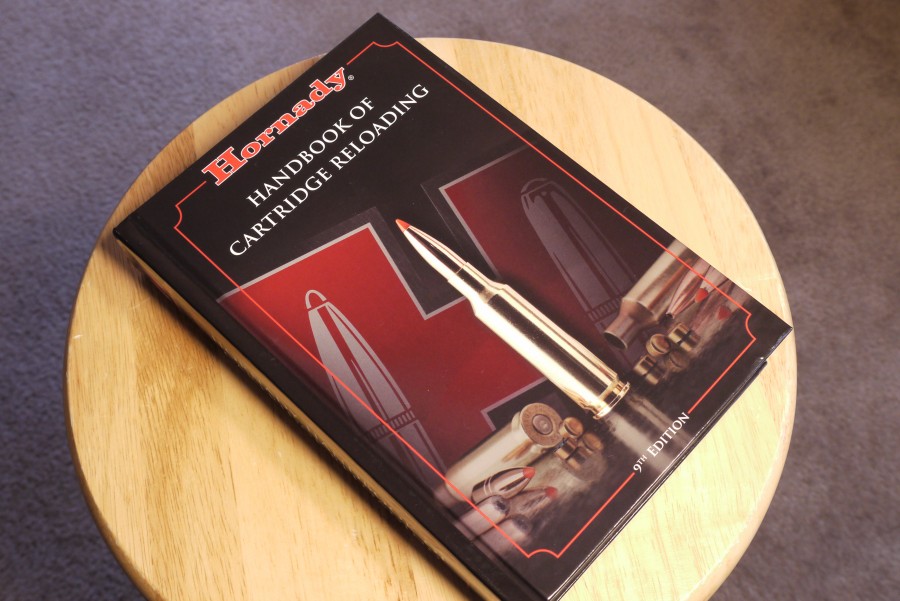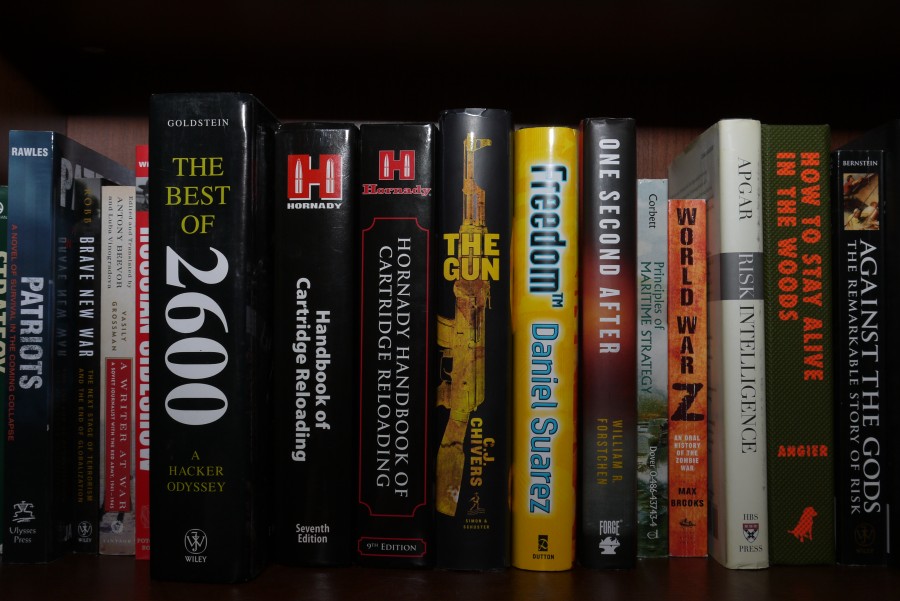In reality there’s very little chance of ever being injured at a gun range. Modern guns are well built, commercial ammo is (generally) very safe and the threat of swift and painful retribution generally keeps people from going berserk. But when you start loading your own ammunition there’s a very, VERY real chance that if you do it wrong you could be seriously injured. Or even die. Which is why when I start working up a load for a new caliber or bullet weight I defer to the experts, who more often than not are employed by Hornady. With the publication of their 9th edition of the Handbook of Cartridge Reloading, I wanted to see if it really is the perfect resource for the beginner. . .
Quick answer: not really.
The book is divided into two sections. The first part is all about the theory of reloading, with the second part simply a compilation of charts showing the various loadings and expected velocities of cartridges with various weights of projectiles.
The first section isn’t really thought out particularly well and reads like an old man is trying to relate every important facet of his years of experience all at once.
The book jumps directly from a leisurely discussion of what a badass Joyce Hornady was when he started the company to a disjointed and overly technical explanation of the finer points of handloading. It’s the exact same overview that ran in the 7th edition (which I bought when I was first starting out) complete with the same pictures and illustrations that look like they were last updated in the 1970s. Maybe.
It’s cool, but for a beginner it might seem like they ran straight into a brick wall. Definitely in some dire need for editing and updating, rather than simply copy-and-pasting the section into each successive volume. Thankfully, the next part is a little better.
What follows is a pretty basic primer on reloading for beginners. I thought I did a fairly good job when I wrote my own Reloading for Dummies article, but Hornady discusses the different kinds of equipment as well.
It’s not bad — “doom and gloom” in parts when it talks about lethal pressures building in barrels if things aren’t done exactly right — but I think it would have been better had it come immediately after the “Hornady is a Badass” portion. Minor editing gripe I know, but when you’re publishing the 9th edition of something, it’s all about the polish.
The next part, though, is the whole reason you buy the book.
The vast majority of this tome is made up of table after table of loads for every caliber and powder combination you could want. The sections are grouped by caliber with a one-page intro on the history of the cartridge and a diagram of the case specifications leading the way. And naturally, for each bullet weight the book helpfully suggests some Hornady projectiles that would work well, complete with item numbers so you can run out and buy them.
Some other companies have published on-line references for hadloaders — Hodgdon comes to mind — but those generally only cover the powders produced by that company and not in any great detail. With Hornady’s manual, not only do you have intermediate loads instead of just the starting and max load, but you get a large variety of bullet weights as well. It’s incredibly detailed information, all verified by Hornady’s technicians. Every time I use a load recipe from this book I’ve gotten remarkably similar results to those printed on the page.
In fact, the first handload I ever fired was taken directly out of the 7th edition. And somehow I had the presence of mind to record that moment for posterity. Probably should have been wearing glasses, though…
In the end, you’re not buying this book for the clear and concise instructions on exactly how to reload ammunition (which is good, since the instructions in this book really are neither clear nor concise). You’re buying it for the massive treasure trove of load information contained within its pages. When you’re loading your own ammo you want to know that the powder charge you’re using is within limits and you want that info coming from someone who knows what they’re doing and has done it before. That’s exactly what this book provides.
If you’re a newbie and wanting to learn how to load your own ammunition, there are better resources out there. The Hornady Handbook gives a rather basic overview, but there’s not a lot of detail on exactly what to do. In fact, that whole section reads more like a product brochure for Hornady gubbins than a how-to guide.
Is it a step up from previous versions, though? Well for me, it is. The 7th Edition didn’t have any data for 300 AAC Blackout, the 9th Edition has it just as fleshed out as every other caliber (and partially pictured above). Is that worth spending the extra $40 though? Not really, if you already have an earlier edition. But if this is your first, then there’s never been a better time to grab a copy.
Hornady Handbook of Cartridge Reloading, 9th Ed.
MSRP: $40
Ratings (out of five)
Usability: * * * *
The overview of reloading leaves a lot to be desired, but the wealth of knowledge in the following pages makes up for it.
Ease of Reading: * * *
Again, the first part is a little disjointed and could use some editing (if not rewriting). But the easy to read and understand tables are the real product being sold.
Overall Rating: * * * *
Its not something that I would advocate running out and purchasing if you already have a reloading manual. But if you’re just getting started or don’t have a manual already its something good to keep on the shelf. The easy to understand tables, backed up by real world testing, is an absolute goldmine and earned its place on my bookshelf.








Very interesting.
I wish I could hand load but 3 smokers live in my house and having powder around could get explody fast.
What’s the worst that could happen??
“What’s the worst that could happen??”
Uh the shoulder thing that goes up, could go off.
We have two smokers and reload. Reload when I am home by myself and go outside to smoke, after I have washed my hands.
My shoulder thingy doesn’t pop up unless I want it to!!! Or if she want’s it to!!!
Not unless you’re using black powder, and maybe not even then. Regular gunpowder doesn’t explode violently because someone is smoking in the house, it might burn and fizzle a lot of you use a tin of powder for an ashtray but that’s about it.
Now if you were loading with propane or gasoline and the fumes built up, then you would have a problem.
Exactly right. Without containment, smokeless powder just deflagrates.
I concur. I’m a bit of a fire bug, and curiosity got the best of me when I started loading. Some powder spilled on the garage floor and I thought “Well, the broom is over there, but I have this zippo right here…” And promptly lit the pile. It flared up with a big orange flame, but I still have my eyebrows. Though the close proximity to my all wood bench gave me a brief moment of pants crapping fear where I was certain our multi unit garage was in serious danger…
That’s a great book and I plan to buy it.
Newbies might consider the popular ‘One Book/One Caliber’ books available at MidwayUSA and other places. Each book is a compilation of available references from all the major bullet and powder manufactures.
A new reloader won’t have to sift through all the exotic calibers and loads. For less than $10, you get a lot of information specific to the caliber you wish to reload.
http://www.loadbooks.com
Lyman’s books are, IMO, better for beginners. Lyman also calls out accuracy loads along with starting loads and max performance loads, and that’s a very handy thing for beginners to see: That the fastest loads are almost without exception never the most accurate loads.
Thank you.
I don’t know about the 9th edition but the 8th edition had watered down the load data. I compared it to Lee’s Modern Reloading and the Lyman Manual and the max loads were considerably lower.
Different guns, different equipment, different components all change things.
I have been using Hornady manuals for 30+ years beucase of the wide variety of cartridges listed. I have odd ball guns like 6.5 and 7.7 Japanese that are not listed in other manuals. Also, Hornady Ballistic Tables are now listed online instead of in the book. I also like the special section in this addition for the M1 Garand, (a section for .308 Service Rifles as well). I buy a new manual every few years beucase of new cartridges being introduced. You will still need to look online for the newest cartridges like 6XC, 6.5 Creedmore, 6.5 Grendel that are too new for this 2007 edition. Check out […] for great information on target and benchrest calibers.
“… I defer to the experts, who more often than not are employed by Hornady.”
Really? Hornady employs most the loading experts in your opinion? That’s news to me. I doubt Barnes, Nosler, Speer, Sierra and others would agree with you.
Damn sentence structure…
The pros I turn to are usually Hornady, not necessarily that most pros are employed by Hornady.
Dont care about .300BLK can someone at Hornandy make some reloadable cases and load data for 5.45×39!!!!
You probably won’t see much interest in that until the surplus ammo runs dry.
There is definitely an interest in non steel 5.45×39, since virtually all indoor ranges ban any ammo which attracts a magnet. For commercial and surplus 5.45×39 that means 100% of it.
Hornady is very conservative with their data. Their Max loads are below the start loads in some of my other manuals.
I agree that the Lyman manuals are much better for a beginner.
Interesting, not listed on Amazon yet, not even for pre-order. Would be nice if it was available in Kindle version.
Nick I just got my Hornady book and it is small in comparison to the Lee Reloading manual and honestly quite disappointing. No bullseye data for the 45 ACP in the 230 jacketed variety but they have Bullseye data for ever other weight in 45 ACP. That was just the first caliber i looked at in the hornady manual. If they cant keep load data for the oldest smokeless powder in a 100+ year old calibers still in wide scale production there is something wrong with horandy.
This site is like a classroom, expect I don’t hate it. lol
When I got started I used the Lyman (49th I beleive), Had everything to get started and I’ve found that most loads are on the soft side. I currently use my Lyman book, Hornady book, and free web load data from the powder companies. Never take from just one source.
I know this post is old, but I’m new to TTAG. Noticed your copy of the best of 2600, wanted to say hello from a fellow hacker and gun guy.